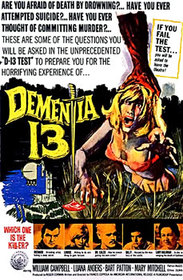Our editor-in-chief Nate Yapp is proud to have contributed to the new book Hidden Horror: A Celebration of 101 Underrated and Overlooked Fright Flicks, edited by Aaron Christensen. Another contributors include Anthony Timpone, B.J. Colangelo, Dave Alexander, Classic-Horror.com's own Robert C. Ring and John W. Bowen. Pick up a copy today from Amazon.com!
Dementia 13 (1963)
Most people don’t associate Francis Ford Coppola with horror, but they should. He produced Jeepers Creepers I and II, Tim Burton’s Sleepy Hollow, a 1999 TV production of Dr. Jekyll and Mr. Hyde, Kenneth Branagh’s Frankenstein, and the Roger Corman classic The Terror. Of course, his direction of Bram Stoker’s Dracula also leaps out. However, the genesis of Coppola’s legendary career as an American directorial icon started with the low-budget slasher thriller Dementia 13.
Coppola was one of many great directors who graduated from the School of Corman, and that list exceeds impressive: John Sayles, Ron Howard, Jonathan Demme, Peter Bogdanovich, and Jack Hill are just some of the cinematic souls that Roger Corman’s vision influenced. Corman proposed Dementia 13 to Coppola while concluding another film shot in Ireland, The Young Racers, in which Coppola was a sound technician. Corman had approximately $22,000 left from The Young Racers’s budget, so he turned to Coppola to direct a film that would emulate Hitchcock’s seminal Psycho, released three years earlier.
Corman’s demands, as usual, were intense for another protégé: the cast had to include actors already on The Young Racers’s payroll (many of whom were Coppola’s UCLA buddies); the film had to be shot in three days and according to Corman’s tight schedule; it had to include a Gothic, castle-like setting and brutal violence; and it had to be shot at night in black and white to save cash.
During post-production, Corman and Coppola disagreed mightily: Corman wanted more violence and voiceovers, so exploitation master Jack Hill (of The Wasp Woman, The Big Doll House, Foxy Brown, and The Switchblade Sisters fame) was summoned to clean up. Corman also wanted the film longer, so he secured Monte Hellman to direct a prologue (available in theatrical releases only) that, while conjuring the gimmicky spirit of William Castle, features a psychiatrist administering a “D-13” test to determine whether the audience was psychologically “fit” to watch the film.
Released by American International Pictures and in England as The Haunted and the Hunted, the film begins with John and Louise Haloran launching a midnight boat ride. They argue about his wealthy mother’s will and Louise’s lack of inheritance; a mysterious “Kathleen” will receive a boatload of the family’s coffers. Suddenly, John dies of a heart attack. Louise inexplicably dumps him in the lake and, seeking to pinch her way into her mother-in-law’s good graces, visits the family estate in Ireland while telling her in-laws her husband is away on business. Louise learns that Kathleen is her husband’s deceased sister who died mysteriously in a childhood accident near the lake, so she tricks Lady Haloran into believing Kathleen is supernaturally communicating with her. Before she can complete her stunt, an axe-wielding maniac rudely greets her along the lake’s shoreline. The family’s doctor arrives to play detective, and he discovers the madman’s identity.
The film’s mood is disturbing, with its ominous, Gothic setting, intricately woven narrative, and dense psychological themes. Depending on your preferences, these traits can easily tilt the wrist “thumbs up” or “thumbs down”. I lean toward the former. The night-for-night shooting is like a dark, heavy mood thrust upon the film’s soul. Subsequently, most viewers will find themselves in the hands of a controlled artist with a master plan, and the general consensus of Dementia 13 was that it revealed “signs of great things to come” from Coppola. However, its convoluted plot may turn many off, with some feeling its intricacies not worth the effort for such a low-budget, “minor” film.
However, that intricate plot is more palatable because of the film’s whodunit twist. As a murder mystery, the film doesn’t shine, but that’s not its focus. Nevertheless, Patrick Magee’s portrayal of the nosy Dr. Justin Caleb is provocative as he maneuvers through that Gothic maze with confidence, and although his snooping is annoying, his foolishness gives viewers something to hang their esteem on (one cannot help but think he might be the maniac-at-large).
As an early installment of the slasher film, Caleb offers viewers a reference point to sift through Coppola’s labyrinthine plot, which is embedded with many of the genre’s conventions: familial violence, weird Oedipal and sibling tensions, an ax-wielding male psychopath, and an innocent female victim. Everyone in the Haloran family seems psychologically challenged, and the complex architecture of their Gothic castle estate reflects this psychic angst.
Slasher fans should enjoy this one, especially as they compare it to Hitchcock’s masterpiece. Psycho is an amazing film, and Dementia 13 is clearly an homage to that masterpiece: the protagonist is killed midway through the plot; Oedipal tensions exist throughout; and each is shot on predominantly limited sets with brooding, intimidating houses lurking in the background. However, their differences are equally eye-opening: with Hitchcock, a detective is killed anticlimactically and rendered useless, but with Coppola, a detective saves the day; with Hitchcock, the psycho survives, but with Coppola, the psycho dies; and with Hitchcock, the lonely characters depict a bleak existential universe whose impersonality instigates anxiety, but with Coppola, it's the family unit and its relationships that prompt familial strife, stress, and dread. Coppola’s film leads to a neatly packaged, feel-good finale; Hitchcock’s film, as it zooms in on Norman Bates’s ominous eyes, leaves us arguably more unraveled than when we started the film.
Dementia 13 offers an interesting glimpse into Coppola’s career. Fans of this site should be proud how often, and how successfully, he, as one of America’s genuine cinematic godfathers, relied on the horror genre to forward that remarkable career.








